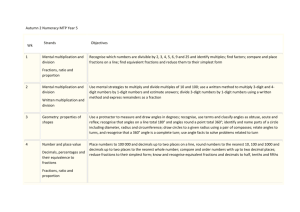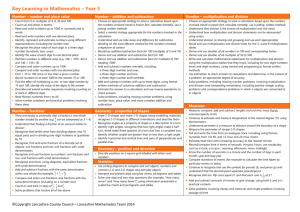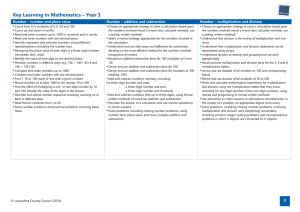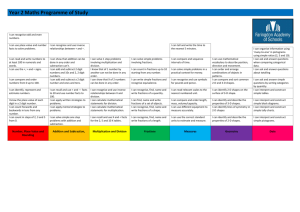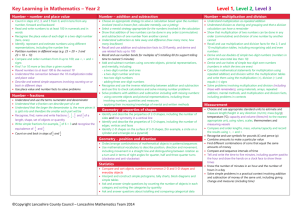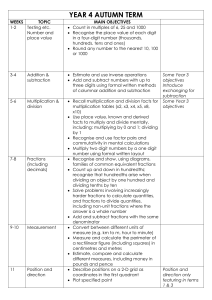Math Scope & Sequence: Number & Algebra, Years 2-5
advertisement
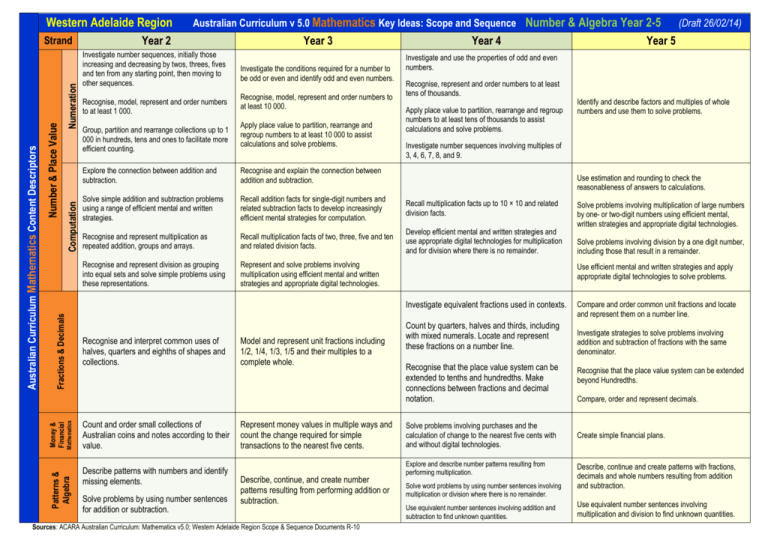
Western Adelaide Region Numeration Computation Number & Place Value Year 2 Investigate number sequences, initially those increasing and decreasing by twos, threes, fives and ten from any starting point, then moving to other sequences. Recognise, model, represent and order numbers to at least 1 000. Group, partition and rearrange collections up to 1 000 in hundreds, tens and ones to facilitate more efficient counting. Year 3 Investigate the conditions required for a number to be odd or even and identify odd and even numbers. Recognise, model, represent and order numbers to at least 10 000. Apply place value to partition, rearrange and regroup numbers to at least 10 000 to assist calculations and solve problems. Year 4 Recognise, represent and order numbers to at least tens of thousands. Apply place value to partition, rearrange and regroup numbers to at least tens of thousands to assist calculations and solve problems. Recognise and explain the connection between addition and subtraction. Solve simple addition and subtraction problems using a range of efficient mental and written strategies. Recall addition facts for single-digit numbers and related subtraction facts to develop increasingly efficient mental strategies for computation. Recall multiplication facts up to 10 × 10 and related division facts. Recognise and represent multiplication as repeated addition, groups and arrays. Recall multiplication facts of two, three, five and ten and related division facts. Develop efficient mental and written strategies and use appropriate digital technologies for multiplication and for division where there is no remainder. Recognise and represent division as grouping into equal sets and solve simple problems using these representations. Represent and solve problems involving multiplication using efficient mental and written strategies and appropriate digital technologies. Mathematics Fractions & Decimals Patterns & Algebra Count and order small collections of Australian coins and notes according to their value. Describe patterns with numbers and identify missing elements. Solve problems by using number sentences for addition or subtraction. Model and represent unit fractions including 1/2, 1/4, 1/3, 1/5 and their multiples to a complete whole. Represent money values in multiple ways and count the change required for simple transactions to the nearest five cents. Describe, continue, and create number patterns resulting from performing addition or subtraction. Sources: ACARA Australian Curriculum: Mathematics v5.0; Western Adelaide Region Scope & Sequence Documents R-10 Year 5 Identify and describe factors and multiples of whole numbers and use them to solve problems. Investigate number sequences involving multiples of 3, 4, 6, 7, 8, and 9. Explore the connection between addition and subtraction. Recognise and interpret common uses of halves, quarters and eighths of shapes and collections. (Draft 26/02/14) Investigate and use the properties of odd and even numbers. Use estimation and rounding to check the reasonableness of answers to calculations. Solve problems involving multiplication of large numbers by one- or two-digit numbers using efficient mental, written strategies and appropriate digital technologies. Solve problems involving division by a one digit number, including those that result in a remainder. Use efficient mental and written strategies and apply appropriate digital technologies to solve problems. Investigate equivalent fractions used in contexts. Money & Financial Australian Curriculum Mathematics Content Descriptors Strand Australian Curriculum v 5.0 Mathematics Key Ideas: Scope and Sequence Number & Algebra Year 2-5 Count by quarters, halves and thirds, including with mixed numerals. Locate and represent these fractions on a number line. Recognise that the place value system can be extended to tenths and hundredths. Make connections between fractions and decimal notation. Solve problems involving purchases and the calculation of change to the nearest five cents with and without digital technologies. Explore and describe number patterns resulting from performing multiplication. Solve word problems by using number sentences involving multiplication or division where there is no remainder. Use equivalent number sentences involving addition and subtraction to find unknown quantities. Compare and order common unit fractions and locate and represent them on a number line. Investigate strategies to solve problems involving addition and subtraction of fractions with the same denominator. Recognise that the place value system can be extended beyond Hundredths. Compare, order and represent decimals. Create simple financial plans. Describe, continue and create patterns with fractions, decimals and whole numbers resulting from addition and subtraction. Use equivalent number sentences involving multiplication and division to find unknown quantities.
